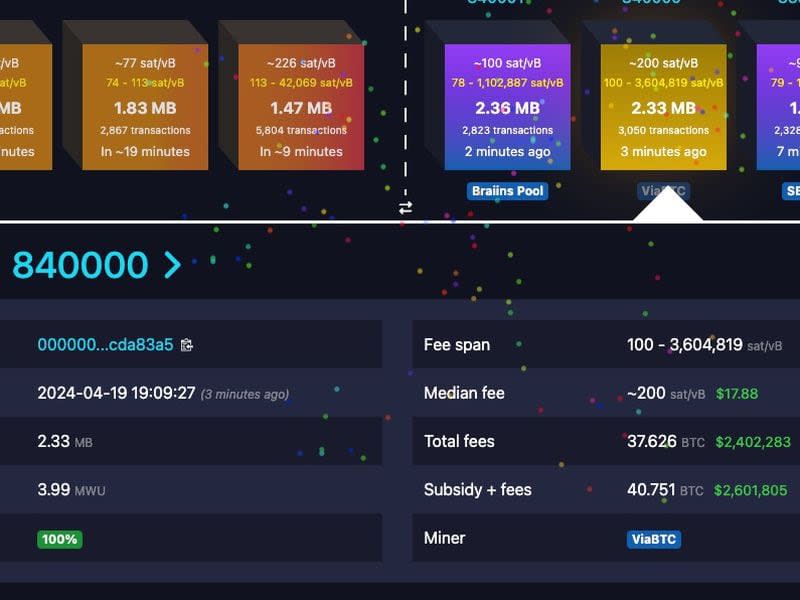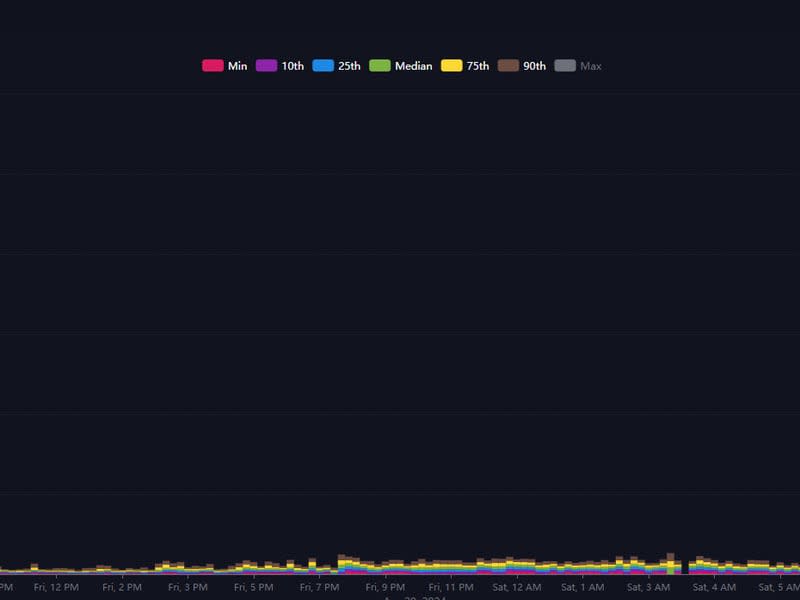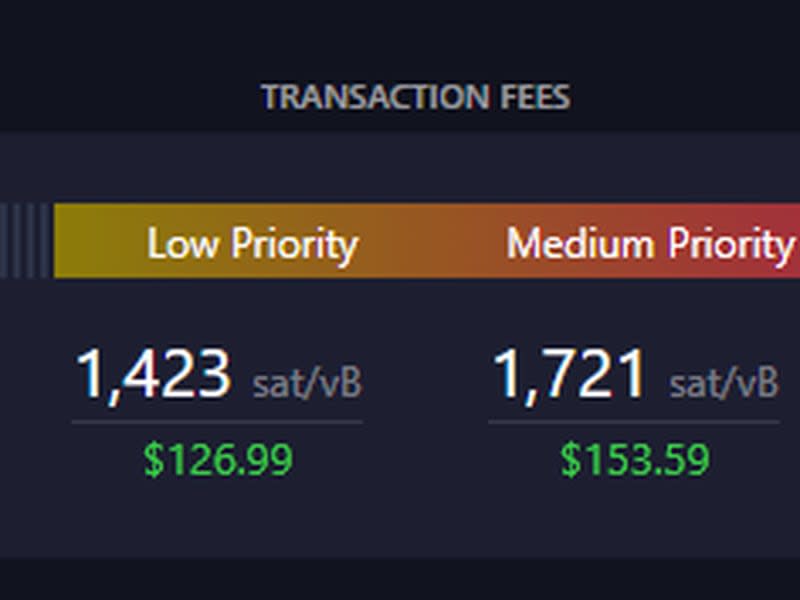The Bitcoin Halving Is Here, and With It a Giant Surge in Transaction Fees
The Bitcoin halving took place early Saturday, upending the economics of running the pioneering blockchain.
Fees soared in the aftermath as a new Bitcoin-based system called Runes launched.
Bitcoin completed the fourth halving in its 15-year history, a milestone venerated and anticipated in the blockchain community just like the World Cup and Olympics are in sports.
The once-every-four-years event, which cuts in half the amount miners get rewarded for creating new bitcoin, took place at 00:09 UTC on Saturday when the 840,000th block was added to the Bitcoin blockchain.
While bitcoin's price held mostly steady above $63,000 in the aftermath, something else stole the show: Transaction fees spiked on Bitcoin as the launch of a new protocol called Runes led to a flurry of transactions as speculators rushed to mint digital tokens atop the blockchain.
Read more: Runes Protocol Launches on Bitcoin, Sending Fees Soaring as Users Rush to Mint Tokens
The halving block – block 840,000 – saw a record-high 37.6 BTC fee (worth more than $2.4 million) attached to it, and fees remained far higher than normal in the hour after the halving.
The winning mining pool for that block was ViaBTC, entitling it to the bitcoin rewards at the new, just-lowered rate of 3.125 BTC per block, worth about $200,000 at the current price. But crypto miners had been competing actively for the block since it contains the first "sat" – the smallest denomination of bitcoin – following the halving. These "epic sats" that follow halvings are seen as collector's items, and some mining executives have suggested that this individual fragment of a bitcoin could be worth millions of dollars, or many multiples of the current price of an entire bitcoin.

The Runes protocol for fungible tokens, from Casey Rodarmor, the developer behind the Ordinals platform that launched last year to enable NFTs on Bitcoin, also launched at block 840,000. Less than an hour after the launch, 853 of the runes had already been etched, according to the website runealpha.xyz.
A quick glance at the fees paid by users to get transactions included in blocks might reflect the intense competition by users to mint the new runes: the $2.4 million fees for the halving block compared with $40,000 to $60,000 for a more typical block before the halving. Several of the ensuing blocks also came with more than $1 million of fees.
"We've not had anything like this in the history of Bitcoin," the prominent Bitcoin developer Jimmy Song said during a livestreamed watch party hosted by Tone Vays. "We're stressing the network in a different way, in ways we've never stressed it before."

On-chain data shows that the median satoshis per byte (sats/vByte) fee has exploded post-halving to 1,805 sats/vByte. Pre-halving on April 19, this most recent median fee was closer to 100 sats/vByte.
(Sats/vbyte (satoshis per byte) is a measurement of the fee rate used to conduct a Bitcoin transaction, indicating how many satoshis (the smallest unit of Bitcoin) you are willing to pay for each byte of data in your transaction.)
In layman's terms, this means that transaction fees have surged, with medium-priority transactions costing $146 and high-priority transactions costing around $170.
Miners are expected to rely more on higher transaction fees and a potential increase in bitcoin's price to offset the expected decline in revenue due to the reduced mining subsidy, especially in the short term.

For CoinDesk's complete coverage, please see our Bitcoin Halving landing page.
The mining reward – which dropped to 3.125 BTC from 6.25 BTC during this halving – is an incentive for entities who contribute computing power to secure Bitcoin. The miner that wins the race to add each new block to the network takes away the mining reward, the amount of which is fixed until it's cut again at the next halving, as programmed by the cryptocurrency's elusive creator, Satoshi Nakamoto. Soaring fees, though, in the aftermath of the halving suggest miners could have a lucrative new revenue stream in the Runes era – though several people speaking on the Tone Vays livestream expressed the belief that the fee spike will end up being temporary.
The quadrennial halving is seen as a momentous occasion in the crypto community because it symbolizes Bitcoin's original concept as an autonomous, decentralized financial network whose monetary policy is set by code, as opposed to human organizations like governments and central bankers.
Unlike traditional, or fiat, currencies, whose value has historically been eroded by inflation and government printing, bitcoin is designed to be non-inflationary with a maximum total supply of 21 million BTC in circulation. With the halvings every four years, the pace of new issuance of bitcoins reduces over time until the last one is mined, likely sometime in 2140.
Read More: Bitcoin Halving, Explained
Historically, halvings have been followed by surges in bitcoin's price. The thinking is that the fewer new BTC are being produced, the more valuable those already in existence become. This time, the outlook is murky. Some market commentators say the halving is already priced into BTC and, therefore, the immediate effects may be muted. Others see the bitcoin price falling, while yet others have suggested a rally is in store.
The potential effects of this present halving may be impossible to predict due to the profound differences in the Bitcoin landscape compared with the three previous events. Notably, January's long-awaited approval of spot bitcoin exchange-traded funds (ETFs) in the U.S. means greater institutional investment is coming to BTC by orders of magnitude.
Also, following the launch of the Ordinals protocol early last year, there is now much greater activity going on under the hood of Bitcoin, with developments and upgrades to the network potentially bringing far more utility to the notoriously conservative ecosystem.

 Yahoo Finance
Yahoo Finance 